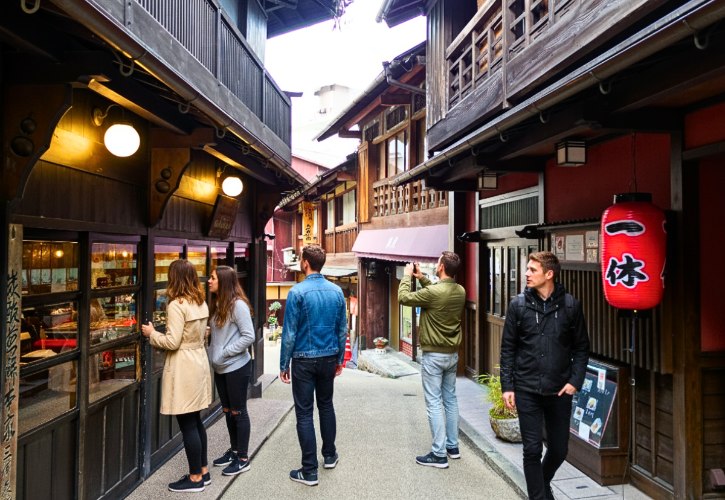
When you’re staying in Osaka or Kyoto, you have some amazing day trip options close by.
These 3 destinations each offer something completely different, and they’re all just a short train ride away.
Let me show you what makes each place special, how to get there, and my suggested itinerary for each one. 😊
1. Kobe – The Cosmopolitan Port City
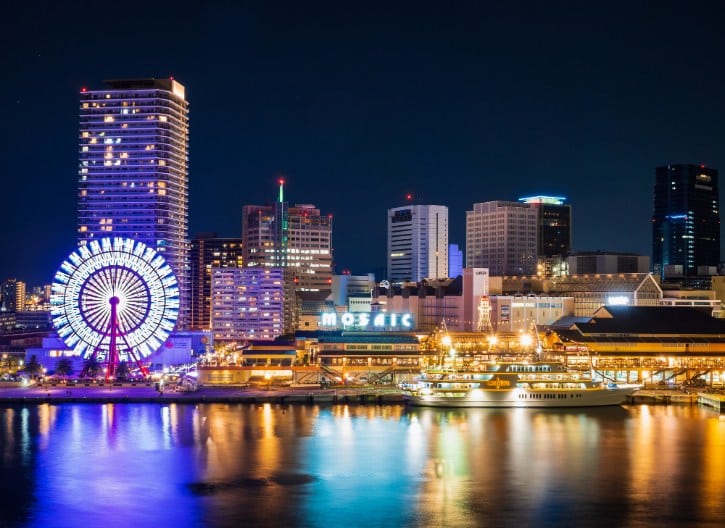
Kobe feels different from other Japanese cities the moment you arrive.
This port city has been welcoming international visitors since 1868, and you can feel that history everywhere.
The city sits perfectly between the mountains and the sea.
You can take a cable car up Mount Rokko in the morning and stroll along the harbor in the afternoon.
a. Top Things to See and Do
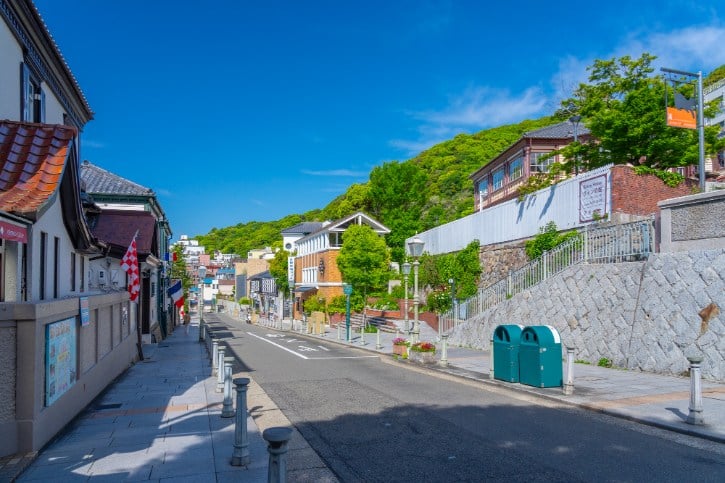
- Kitano-cho: This hillside neighborhood is full of old Western-style houses from the 1800s. Many are now museums or cafes where you can step inside and explore.
- Kobe Harborland: The waterfront shopping and dining district with the iconic red Port Tower. Great restaurants, an open-air mall, and beautiful night illuminations make this a fun spot any time of day.
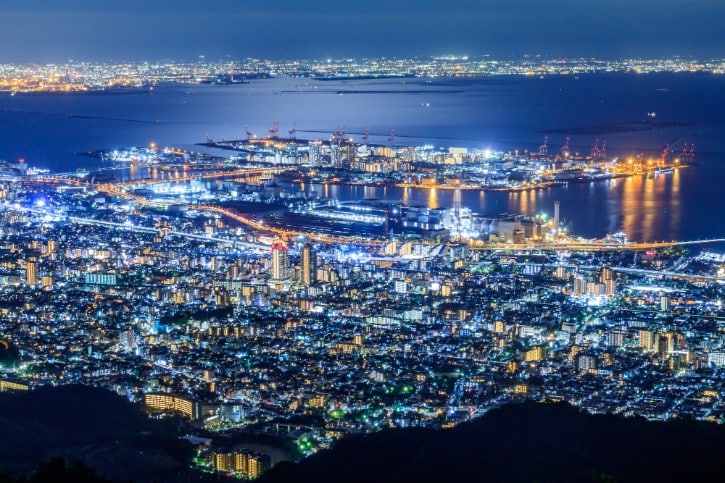
- Mount Rokko: Take the cable car up for incredible views. The night view from here is called the “10-million-dollar view” for a reason.
- Ikuta Shrine: A bright vermillion shrine dating back 1,800 years, right in the city center. Popular with locals praying for love and good relationships.
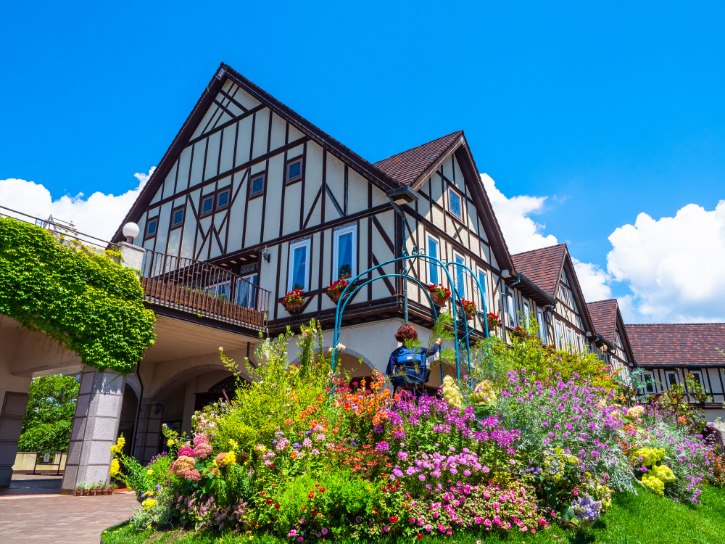
- Nunobiki Herb Gardens: Take the ropeway up the mountain to Japan’s largest herb garden. You’ll find 200 varieties of herbs and flowers, plus amazing views of the city and bay below.
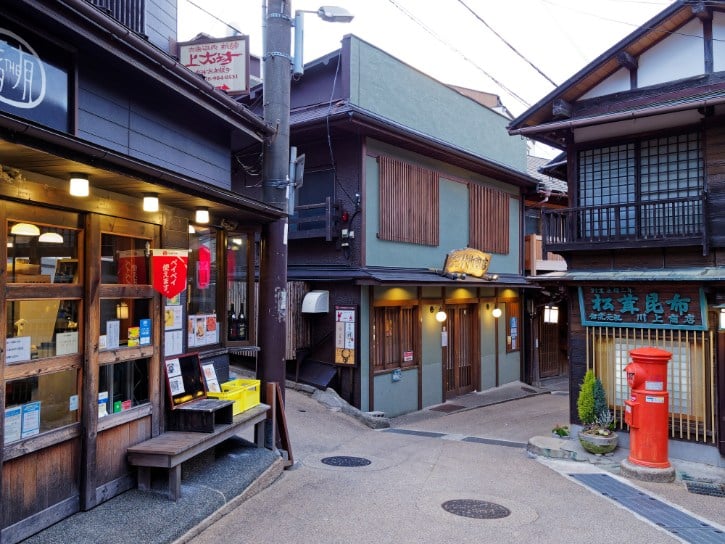
- Arima Onsen: One of Japan’s oldest hot spring towns is just 30 minutes from central Kobe. Perfect if you want to soak in mineral-rich waters after sightseeing.
- Nankinmachi Chinatown: Small but lively, with colorful gates and street food everywhere. Go hungry.
b. Food You Can’t Miss
- Kobe Beef: Yes, it’s worth it. For a more affordable option, try Steakland Kobe near Sannomiya Station. Their lunch special gives you the real deal without breaking the bank.
- Akashiyaki: Think of these as takoyaki’s more elegant cousin. Soft, eggy dumplings with octopus inside, served with warm dashi broth for dipping. Try them at Akashiyaki Tsukasa near Sannomiya.
- Nada Sake: This district makes some of Japan’s best sake. Visit Hakutsuru Sake Brewery Museum for free tours and tastings.
- Chinatown Pork Buns: Line up at Roushouki in Nankinmachi for their famous bite-sized pork buns. Trust me, the wait is worth it.
c. Getting There
From Osaka:
- Fastest: Take JR Kobe Line (Special Rapid) from Osaka Station to Sannomiya Station (22 minutes, ¥420)
- Most affordable: Take Hankyu Kobe Line Limited Express from Osaka-Umeda Station to Kobe-Sannomiya Station (27 minutes, ¥330)
- Alternative: Take Hanshin Main Line Limited Express from Osaka-Umeda Station to Kobe-Sannomiya Station (31 minutes, ¥330)
From Kyoto:
- Fastest: Take Tokaido-Sanyo Shinkansen (Nozomi) from Kyoto Station to Shin-Kobe Station (30 minutes, ¥2,870)
- Best value: Take JR Kyoto Line (becomes JR Kobe Line) from Kyoto Station to Sannomiya Station (50 minutes, ¥1,110)
- Budget option: Take Hankyu Kyoto Line from Kyoto-Kawaramachi Station to Juso Station, transfer to Hankyu Kobe Line to Kobe-Sannomiya Station (70 minutes, ¥640)
d. A Sample Day Trip Plan
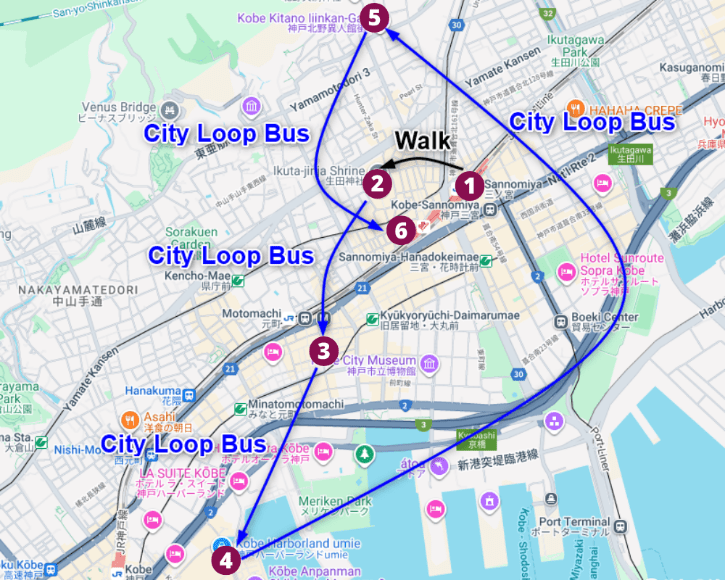
You can easily get around Kobe using the City Loop Bus, which stops at most major attractions. For more details, check here.
- Sannomiya Station – 9:30 AM
- Ikuta Shrine – 9:40 AM
- Nankinmachi Chinatown + Lunch – 10:43 AM
- Kobe Harborland + Kobe Port Tower – 12:50 PM
- Kitano-cho – 3:35 PM
- Dinner at Steakland Kobe near Sannomiya Station – 6:10 PM
- Return to Osaka or Kyoto – 7:10 PM
2. Nara – Cradle of Ancient Japan
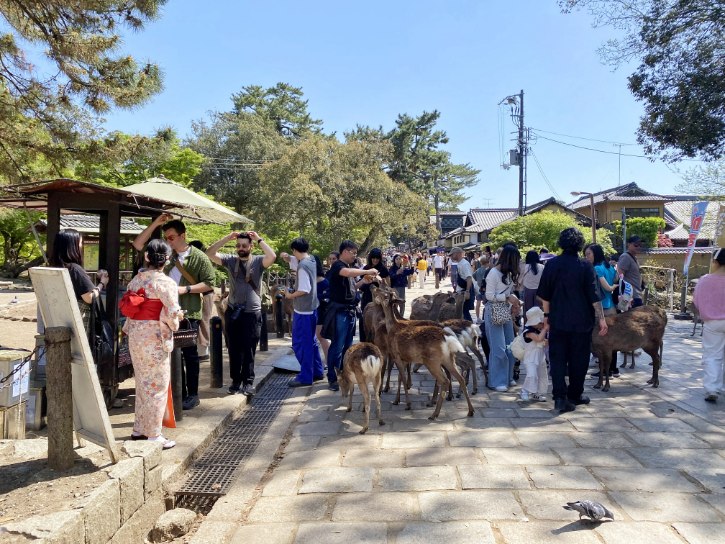
Nara was Japan’s first permanent capital back in 710. Today, it’s famous for something else entirely: over 1,000 deer roaming freely through the parks.
These aren’t zoo animals. They’re wild deer that have become completely comfortable around people.
Buy some deer crackers, bow to them, and watch them bow back. It never gets old.
The best part? Most of the main sights are within walking distance of each other. You can see everything in a relaxed day trip.
a. Top Things to See and Do
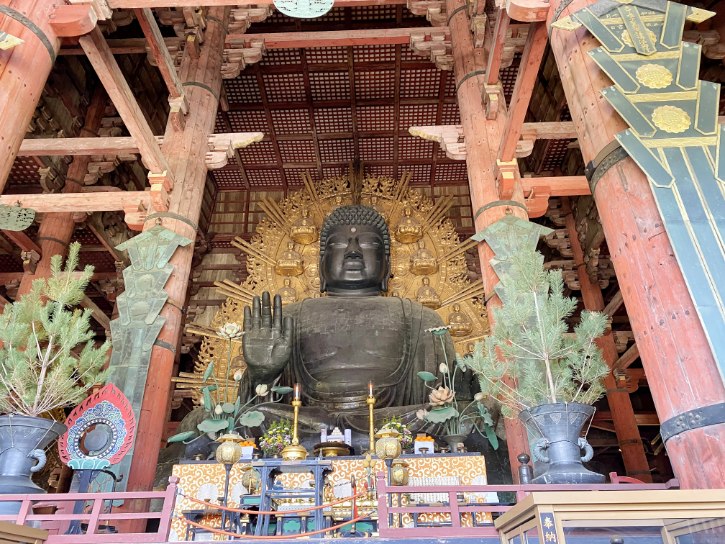
- Todai-ji Temple: Home to the enormous bronze Buddha statue. The building itself is one of the world’s largest wooden structures.
- Kofuku-ji Temple: A UNESCO World Heritage Site that showcases Nara’s deep Buddhist roots and stunning classical architecture.
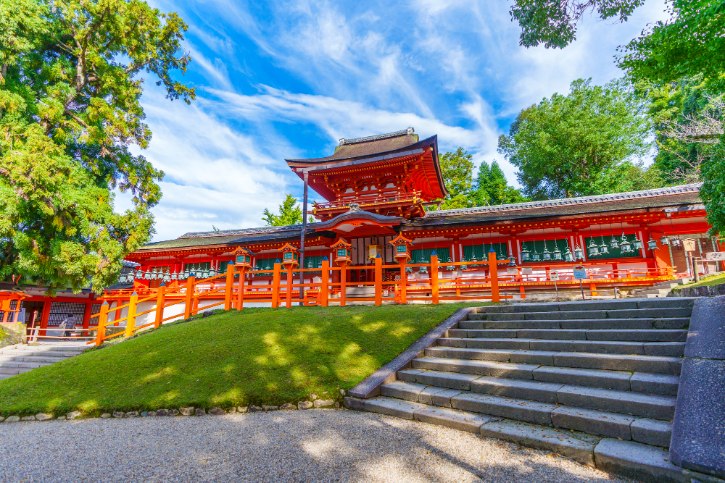
- Kasuga Taisha Shrine: Follow paths lined with thousands of stone lanterns through the forest. It feels like walking into another world.
- Nara Park: This is where you’ll meet the deer. They’re everywhere, and they know you have crackers.
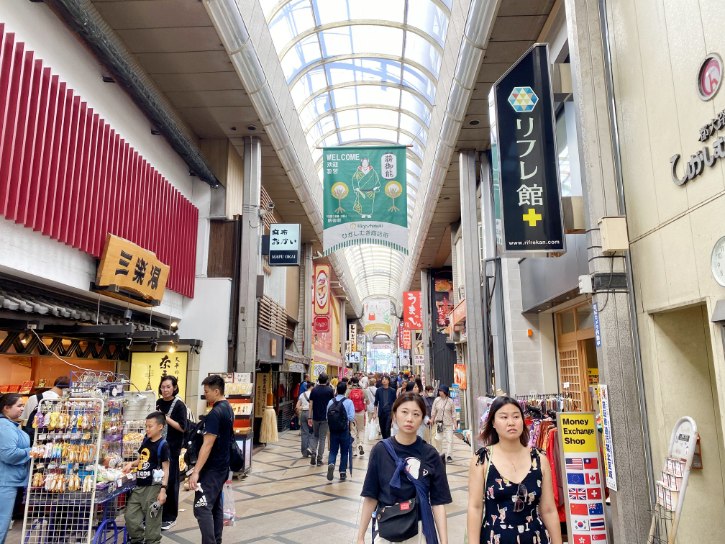
- Higashimuki Shopping Street: A lively covered arcade lined with shops, snacks, and souvenirs. Perfect for a quick stroll before heading back.
- Naramachi: The old merchant quarter has narrow streets with traditional houses, now converted into cafes and shops. Perfect for a quiet stroll.
b. Food You Can’t Miss
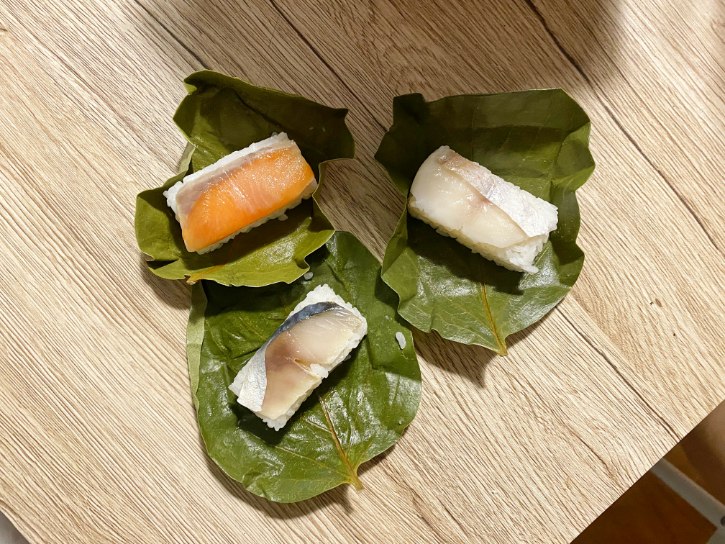
- Kakinoha-zushi: Pressed sushi wrapped in persimmon leaves. The leaf adds a subtle flavor and keeps the fish fresh. Try it at Kakinohasushi Hompo Tanaka.
- Yomogi Mochi: Watch the famous high-speed mochi pounding at Nakatanidou. The warm, green rice cakes filled with red bean paste are incredible.
- Narazuke: These pickles aged in sake lees have a unique, slightly alcoholic taste. You’ll find them everywhere as souvenirs.
c. Getting There
Here’s an important tip: Kintetsu-Nara Station is much closer to the park than JR Nara Station. It saves you about 15 minutes of walking each way.
From Osaka:
- Best location: Take Kintetsu Nara Line (Rapid Express) from Osaka-Namba Station to Kintetsu-Nara Station (35-40 minutes, ¥680)
- From Osaka Station: Take JR Yamatoji Line (Yamatoji Rapid) from JR Osaka Station to JR Nara Station (50 minutes, ¥820)
From Kyoto:
- Fastest: Take Kintetsu Kyoto Line (Limited Express) from Kintetsu Kyoto Station to Kintetsu-Nara Station (35 minutes, ¥1,280)
- Regular express: Take Kintetsu Kyoto Line (Express) from Kintetsu Kyoto Station to Kintetsu-Nara Station (45 minutes, ¥760)
- JR option: Take JR Nara Line (Miyakoji Rapid) from JR Kyoto Station to JR Nara Station (44 minutes, ¥720)
d. A Sample Day Trip Plan
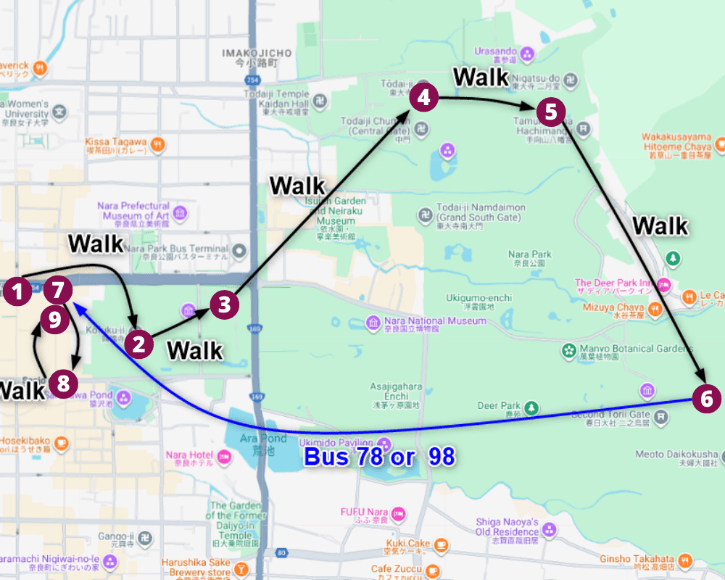
- Kintetsu-Nara Station – 9:25 AM
- Kofuku-ji Temple – 9:30 AM
- Nara Deer Park – 10:30 AM
- Todai-ji Temple – 11:30 AM
- Lunch at Todaiji Emado Chaya – 12:30 PM
- Kasuga Taisha Shrine – 3:00 PM
- Higashimuki Shopping Street – 4:30 PM
- Nakatanidou Mochi Shop – 5:30 PM
- Dinner at Tonkatsu Ganko Nara – 6:00 PM
- Return to Osaka or Kyoto – 7:00 PM
Read More: Nara Day Trip from Osaka or Kyoto
3. Biwako Valley and Lake Biwa (Shiga) – A Breath of Fresh Air
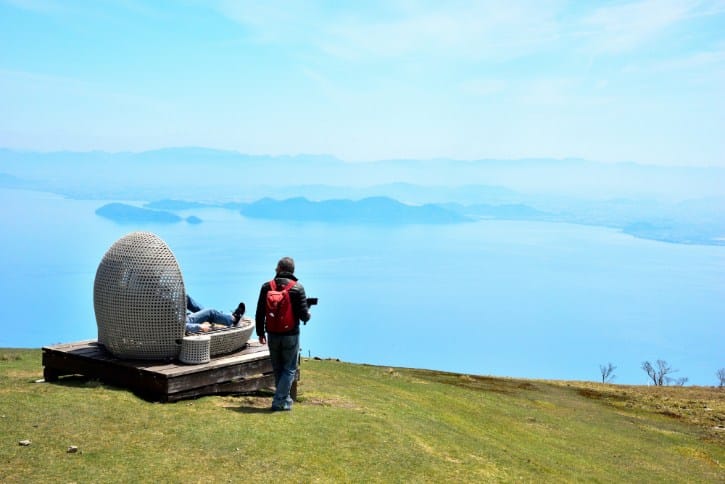
Lake Biwa is huge. It’s Japan’s largest lake, and it offers something you won’t find in the cities: wide open spaces and mountain air.
The star attraction is Biwako Valley, where you can take Japan’s fastest ropeway up the mountain. The view from the top is spectacular.
In winter, it becomes a ski resort. In summer, it’s all about hiking and those incredible terrace cafes at the summit.
a. Top Things to See and Do
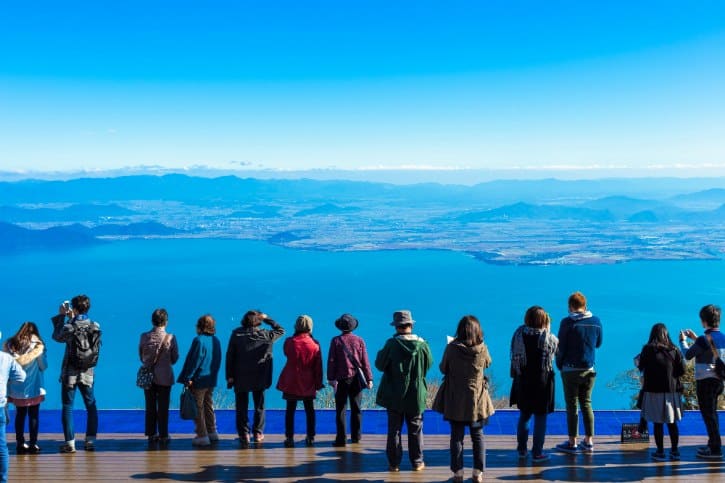
- Biwako Valley Ropeway: The five-minute ride up is thrilling. The glass cabin gives you 360-degree views as you climb.
- The Biwako Terrace: Multiple observation decks at the summit. The infinity pools create the illusion that you’re floating above the lake.
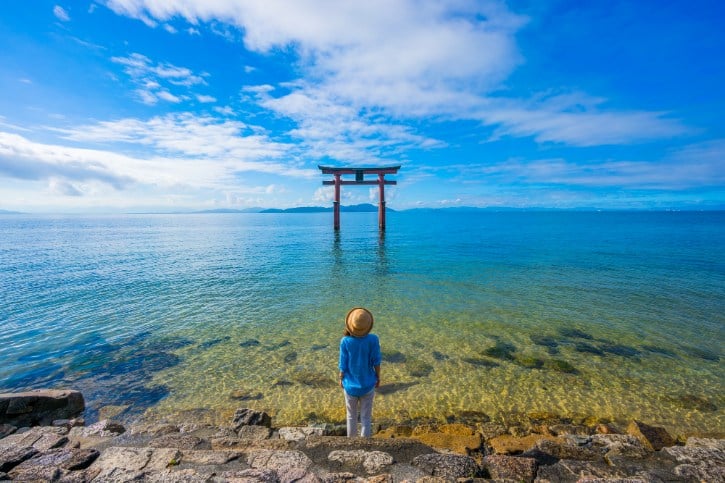
- Shirahige Shrine: A red torii gate standing in the lake water. Come at sunrise for the best photos.
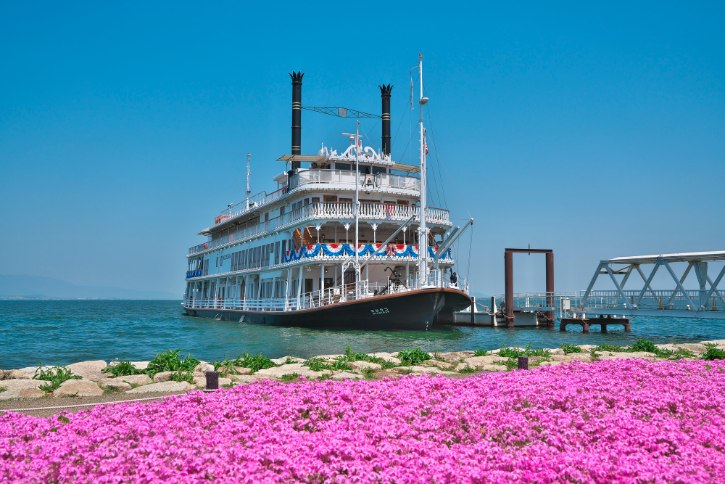
- Michigan Cruise: Ride an American-style paddle boat across the lake. The sunset cruise is especially nice.
- Omihachiman: Take a boat ride through the canals of this preserved merchant town. It feels like stepping back to the Edo period.
b. Food You Can’t Miss
- Omi Beef: One of Japan’s top three wagyu brands. Try it at Matsukiya in Otsu for the full experience.
- Funazushi: This fermented fish is definitely an acquired taste. It’s been made here for over 1,000 years. Brave souls can try it at Korian in Takashima.
- Lake Fish: Simple grilled sweetfish or Biwa trout. Most lakeside restaurants serve these seasonal catches.
- Red Konjac: This bright red jelly is unique to the area. You’ll see it in local restaurants around Omihachiman.
c. Getting There
Getting to Biwako Valley takes two steps: train to Shiga Station, then bus to the ropeway.
From Osaka:
- Take JR Kyoto Line from Osaka Station to Kyoto Station (30 minutes, ¥580), then transfer to JR Kosei Line to Shiga Station (40 minutes, ¥590). Total: 1 hour and 10 minutes, ¥1,170
- From Shiga Station, take the Kojaku Bus to Biwako Valley Ropeway Station (10 minutes, ¥410)
From Kyoto:
- Take JR Kosei Line directly from Kyoto Station to Shiga Station (40 minutes, ¥590)
- Same bus connection from Shiga Station (10 minutes, ¥410)
d. A Sample Day Trip Plan
- Shiga Station – 9:40 AM
- Ride the ropeway to Biwako Terrace – 10:00 AM
- Biwako Terrace – 10:05 AM
- Lunch at Biwako Terrace Mountain Restaurant – 1:00 PM
- Shirahige Shrine – 3:00 PM
- Shirahige Shrine Torii & Lake Biwa – 4:00 PM
- Return to Osaka or Kyoto – 5:30 PM
Bonus: Uji – The Heart of Green Tea
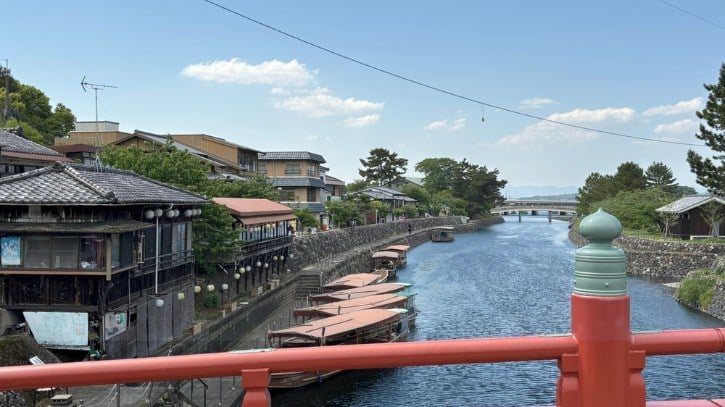
Everything in Uji revolves around tea. The streets smell like roasting hojicha. The desserts are bright green. Even the noodles are infused with matcha.
This town has been growing Japan’s finest tea for 800 years. It’s also where the world’s first novel, The Tale of Genji, was set.
Plus, the new Nintendo Museum opened here in 2024, adding a fun modern twist to this historic town.
a. Top Things to See and Do
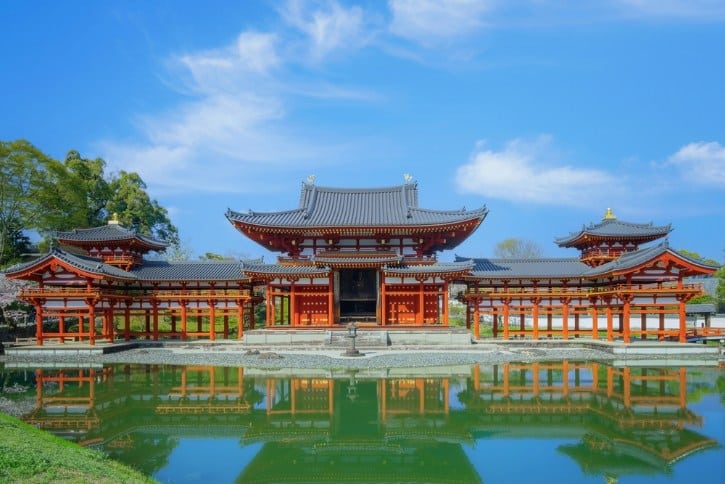
- Byodo-in Temple: You’ve seen this on the 10-yen coin. The Phoenix Hall floating over its pond is even more beautiful in person.
- Ujigami Shrine: Japan’s oldest shrine building, dating from 1060. It’s quiet and peaceful, often with no crowds.
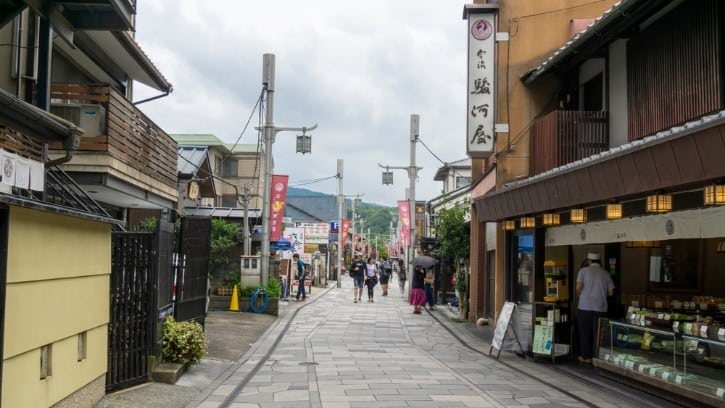
- Byodo-in Omotesando: The street leading to the temple is lined with tea shops. Perfect for trying matcha everything.
- The Tale of Genji Museum: Learn about the famous 11th-century novel through displays and films. They have English guides available.
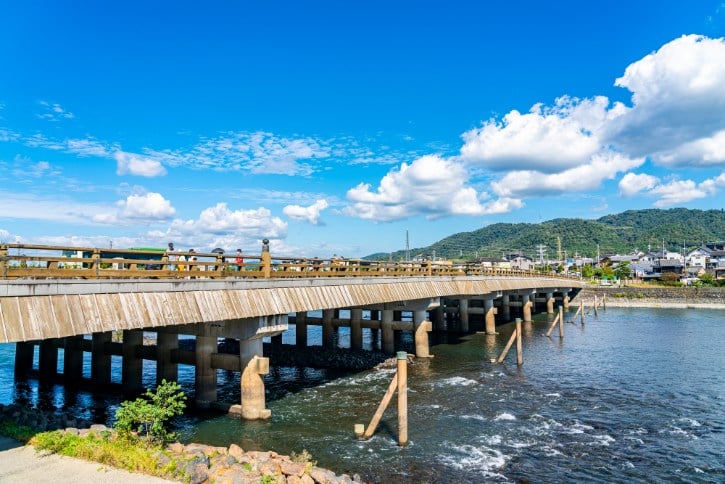
- Uji River and Bridge: Nice riverside walks and boat rides. In summer, you can watch traditional cormorant fishing at night.
- Nintendo Museum: Brand new as of 2024. A fun contrast to all the ancient temples.
b. Food You Can’t Miss
- Matcha Parfait: The one at Nakamura Tokichi Honten is legendary. Layers of matcha ice cream, jelly, red beans, and mochi in a bamboo tube.
- Matcha Soba: Green tea noodles at Tsuen Tea, Japan’s oldest tea shop (founded in 1160!). Refreshing when served cold.
- Matcha Ice Cream: Every shop along Omotesando has its own version. Try a few different ones as you explore.
- Pure Matcha: Have at least one bowl of traditional whisked matcha. The tea house at Taiho-an in Uji Park offers a proper tea ceremony experience for about ¥2,400.
c. Getting There
Uji has two stations on opposite sides of the river. You can arrive at one, walk through town, and leave from the other. Smart, right?
From Osaka:
- JR route: Take JR Kyoto Line from Osaka Station to Kyoto Station (30 minutes, ¥580), then transfer to JR Nara Line (Rapid) to JR Uji Station (18 minutes, ¥240). Total: 48 minutes, ¥990
- Keihan route: Take Keihan Main Line from Yodoyabashi Station to Chushojima Station, then transfer to Keihan Uji Line to Keihan Uji Station. Total: 60 minutes, ¥870
From Kyoto:
- Fastest: Take JR Nara Line (Rapid) directly from JR Kyoto Station to JR Uji Station (18 minutes, ¥240)
- Local train: Take JR Nara Line (Local) from JR Kyoto Station to JR Uji Station (23 minutes, ¥240)
- From central Kyoto: Take Keihan Main Line from Gion-Shijo or Sanjo Station to Chushojima Station, then transfer to Keihan Uji Line to Keihan Uji Station (30-35 minutes, ¥360-¥400)
d. A Sample Day Trip Plan
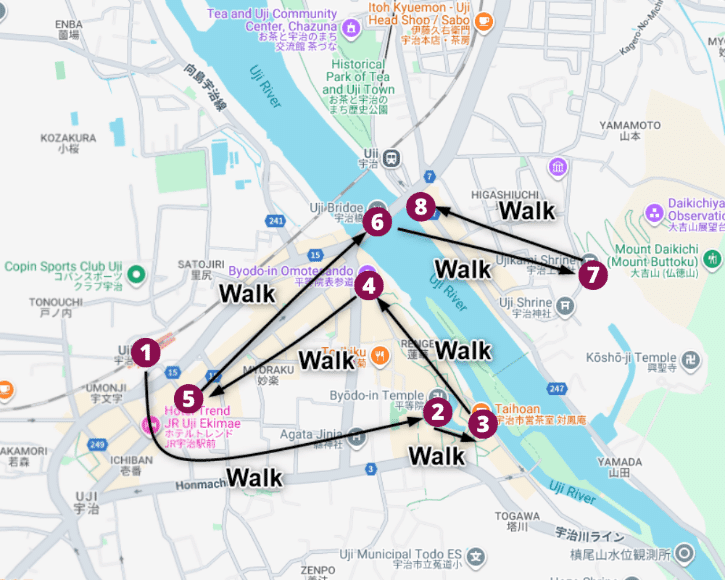
- JR Uji Station – 8:50 AM
- Byodoin Temple – 9:00 AM
- Taiho-an – 11:00 AM
- Byodo-in Omotesando – 12:00 PM
- Lunch at Nakamura Tokichi Honten – 1:30 PM
- Uji Bridge – 2:30 PM
- Ujigami Shrine – 3:00 PM
- Tsuen Tea – 4:00 PM
- Head back to Osaka or Kyoto – 5:00 PM
Related Posts
Photo Credit:
Photos by PIXTA

